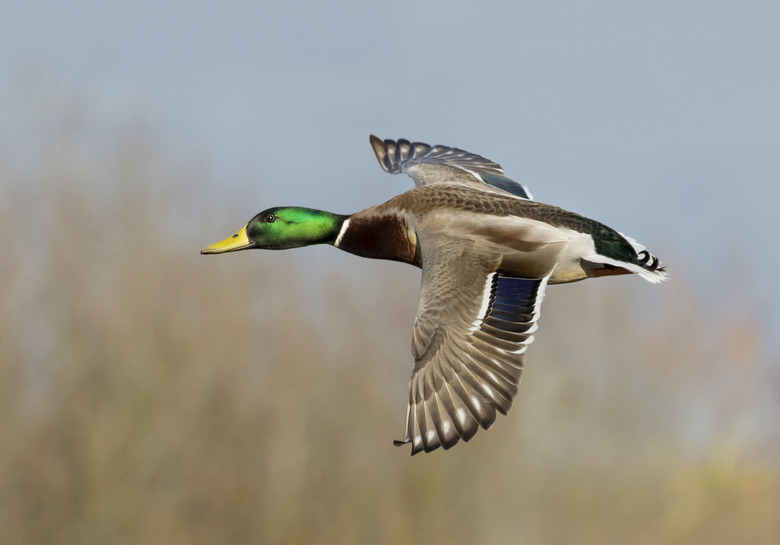Mallard Duck Nesting Habits
Mallards begin courtship in the fall and form pairs by early winter. In late March and early April, the pairs migrate back to the female's territory close to where she was born, or where she previously nested. During the courtship and mating, the drake's head takes on a purple hue. This color gradually changes to black after the female lays her eggs. Mallards build nests on the ground close to ponds and lay about a dozen eggs. Chicks can swim and feed within a day after hatching.
Drake
Drake
The drake begins seeking a mate in the fall — before duck laying season. At this time, his head colors take on a green sheen to help impress the females. Once he has paired with a female, he will remain with her until approximately 10 days after the mallard hen begins to incubate her eggs. If the eggs are destroyed, he will mate with her a second time. He leaves the incubation and rearing of the young to the female and rejoins a flock of all males for the rest of the summer.
Mallard Duck Nest
Mallard Duck Nest
The mallard hen builds a nest in natural depressions in the ground. She chooses a nest area very close to water, usually no more than 100 yards, where there are long grasses, reeds or low bushes for her to use as cover. She makes her nest out of grass, weeds, rushes, down and any other material near the nest area. She lines the main depression where the eggs will lay with soft down from her breast.
Mallard Eggs
Mallard Eggs
The female does not lay her eggs all at once; she will lay up to a dozen dull green or white eggs over a period of days. She does not begin incubating the eggs until she lays the last egg. During the days that she lays her eggs, she will leave the nest and join the drake to forage for food. During incubation, when she leaves the nest to eat, she hides the eggs with vegetation or down from the nest.
Mallard Chicks
Mallard Chicks
The eggs take between 28 to 30 days to incubate and all of them usually hatch within one to two days. The chicks emerge from the shell covered in fine brown down. The hen brings her chicks to water within a day of hatching to teach them to swim. During the journey to water, she will stop frequently to gather the slower chicks to her and may gather them under her to warm. Within eight to 10 days, the chicks are ready to survive on their own and the female abandons them.
Cite This Article
MLA
David, Diana. "Mallard Duck Nesting Habits" sciencing.com, https://www.sciencing.com/mallard-duck-nesting-habits-8096988/. 22 November 2019.
APA
David, Diana. (2019, November 22). Mallard Duck Nesting Habits. sciencing.com. Retrieved from https://www.sciencing.com/mallard-duck-nesting-habits-8096988/
Chicago
David, Diana. Mallard Duck Nesting Habits last modified March 24, 2022. https://www.sciencing.com/mallard-duck-nesting-habits-8096988/
